Breadcrumbs
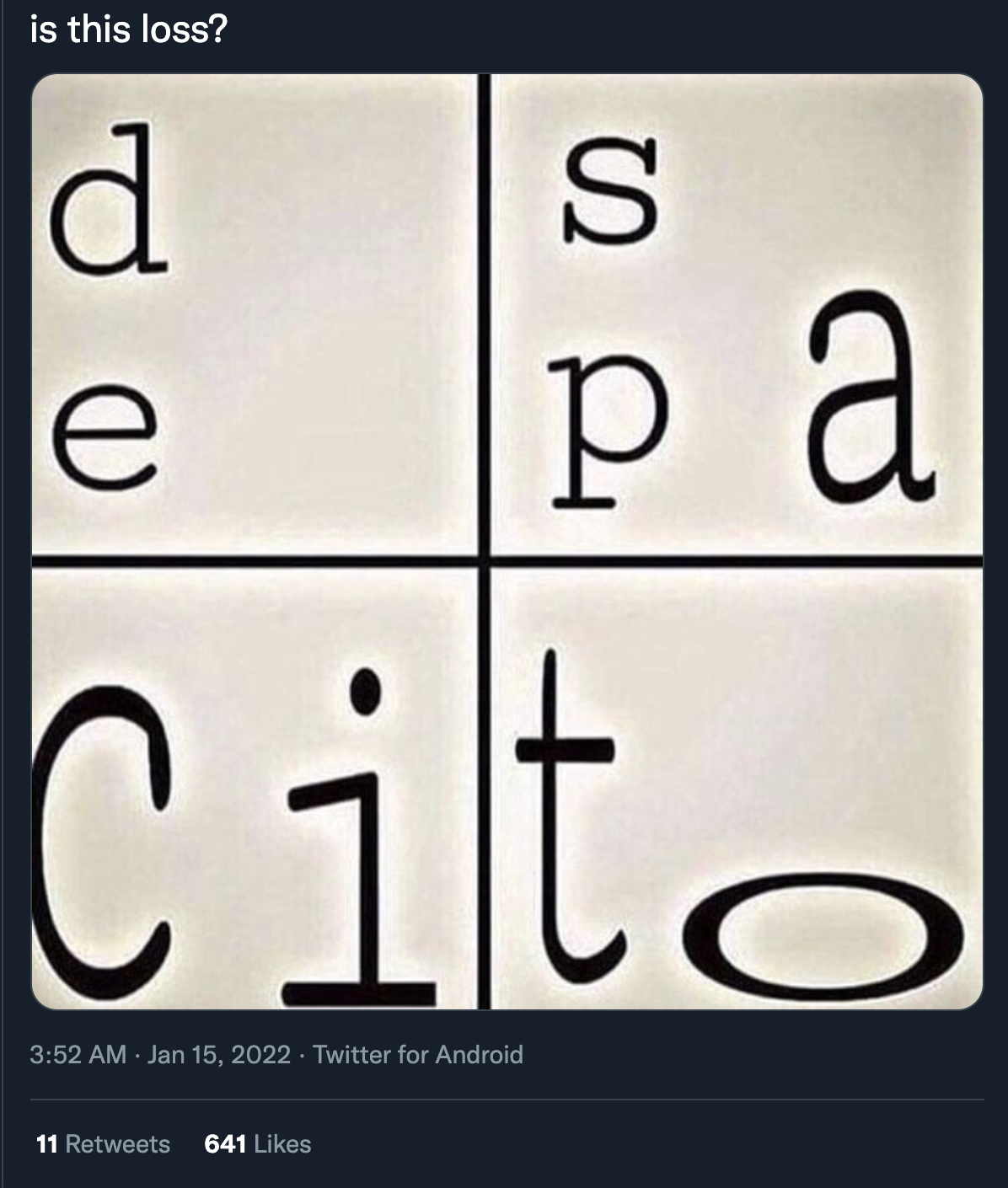
If you spend time perusing social media, most of the posts you see on your feed are self-contained bites of information. But every once in a while, you come across something that seems like the hook to a larger story, extending beyond the formal parameters of a single post. Imagine for a second: You’re browsing Twitter, and encounter the above image. “Is ... de..spA..Ci...To... loss!?” The visual language doesn’t make sense on its own, floating arbitrarily in a stream of algorithmically-curated content. But something about it — maybe the strange question it’s asking, or the fact that it has over 600 likes — indicates that, in some context, it does say something. It’s not just shitposting noise, but a signal suggesting the existence of more signals, a breadcrumb leading to more posts connected to the same story.
The “larger story” here is the world in which the post is legible. It’s the lore that describes the origin of its language and how to decipher it. In the case of the above image, the lore extends back to 2008, when Ctrl+Alt+Del released a web comic titled ‘Loss’. The details of how the comic transformed into a viral meme (of which above image is an instance) aren’t really relevant here. What’s more interesting is the mode of storytelling that makes it persist in internet memory, continuing to propagate new iterations adapted to the present. (I’ve even seen a couple Wordle versions.) Fourteen years ago, when the original comic was posted, it was just that: a comic. Its storyline was contained to Ctrl+Alt+Del. However, upon exposure to the digital public, a gap opened up between the author’s intended message and its readers’ interpretations. This happens with all writing. But in the case of ‘Loss,’ that liminal space became an arena for play, in the most active sense of the word. More and more people circulated the image, tweaking it to suit the specific characteristics of the communities they wished to share it with, transmitting a mutated version of its origin story. Suddenly each instance was a meme, part of a family lineage radiating outward from the original comic, an artifact of repeated breakdown and reconstruction of meaning.
We can imagine the lore behind the ‘is this loss’ meme as a cloud of ancestral nodes connected by branching paths. Each branch encodes the process of copying, editing, and re-contextualizing that produces a new version of the meme. This kind of networked narrative emerges when text and image adapt to the protean, fragmented nature of data broadcast through the internet’s many channels. In this messy web of hypertext, writing does more than present fixed language in a prescribed sequence. Unlike books or movies or Twitter threads, its components retain independent livelihoods, morphing and re-emerging unpredictably. This writing can act like verbal speech, only reaching witnesses in a certain range before fading away. It can also act like a physical object. Bits of text or image can carry concrete evidence of a digital event far from its original site, where it gets interpreted differently. The complicated information contextualizing those objects remains largely embodied and unformalized. We’ll elaborate on these spatial qualities later. First, let’s talk more about the similarities to speech.
The transience and unpredictability of the written data that composes internet lore evokes orality, a form of communication in which stories are more like living organisms than static documents. Sometimes online communities make wikis or YouTube explainers to keep track of certain storylines, but many seem to persist without ever being recorded. Shared memory is often maintained in ways that don’t translate to the readable archives produced by print-based textual tradition. On some level, this feels paradoxical, like the internet should actually automate that archival process for us. But text on the web doesn’t always lend well to indexing — by person or computer. Once something is posted online, its lifespan has only just begun. What happens next depends on the host-platform’s protocols for interactivity. Usually, it joins all the other posts, floating along the winds of the algorithm, remaining subject to editing and deletion. Plus, sheer forgetting: whatever information the internet perma-records, it’s more than our brains can parse and store. The more data we confront, the more we must filter out, to be forgotten about in the steady jetstream of more new content.
So, we find ways to write stories in compact, modular bites. We compress information into shorthand, idioms or symbols, pieces of text and image that convey the potential for meaning, despite its absence on first glance. The result is a puzzle piece that lends itself to reconstruction. We learn how to reverse-engineer existing stories, to read by recognizing patterns in streams of discrete content. We latch on to things that track with our own frameworks for understanding, but also to signals that only gesture or wink at them. These coy signals, promising to make us literate in idioms we don’t yet understand, lead us down hyperlinked, branching rabbit holes of lore. This lore provides entry-points into websites you’d never have known about or how to find. You join other people there, stringing together the idioms that brought you together.
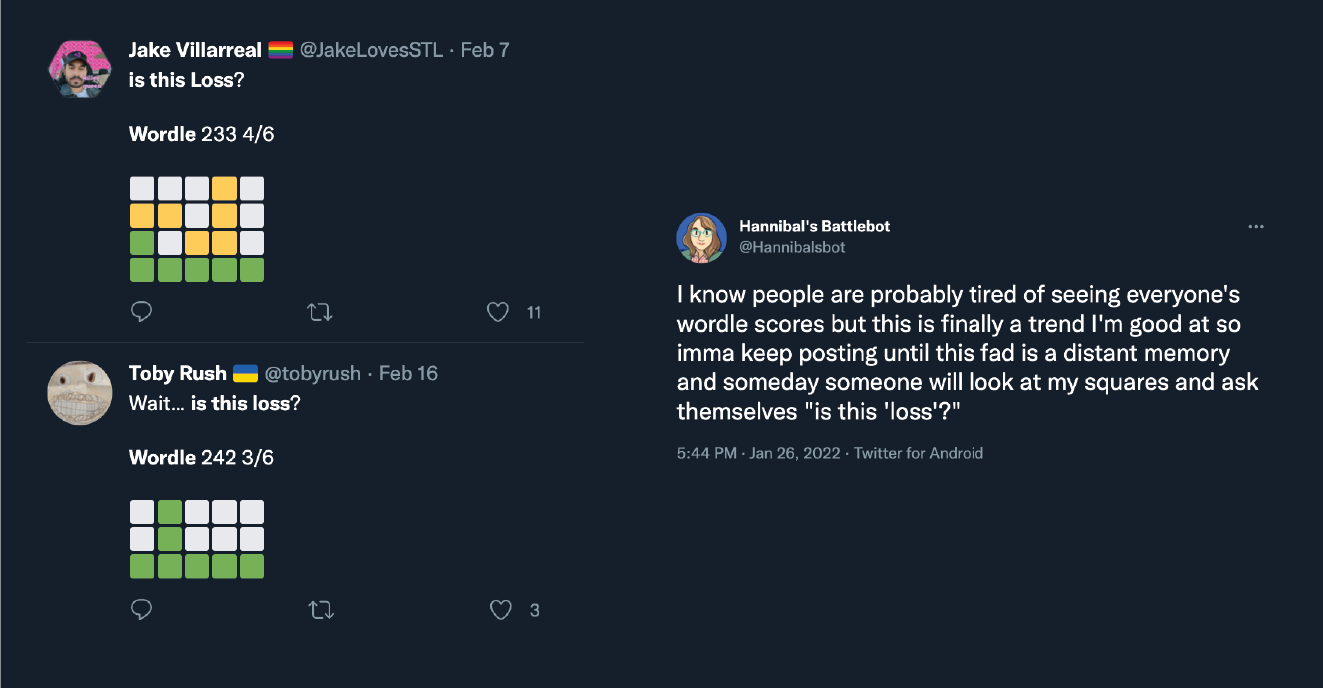
This communal meaning-making through cycles of abstraction and concretization is the oil in the machine of language itself. In conditions where more knowledge remains embodied in memory than in written archives, there’s a greater need for modular linguistic fragments that signify highly situational, nuanced meaning. To illustrate this, cultural anthropologists commonly reference the orally-derived idioms found in the poetry of Homer. His phrase “green fear”, for example, “carries the connotation of a fear that has its origins in a supernatural source” (in the words of scholar John Miles Foley). ‘Green’ efficiently reveals a concentrated, bespoke message in its immediate spoken context. In contrast to languages with textual lexicons, Foley writes, “oral tradition languages are more densely idiomatic, with designated parts standing for much larger and complex wholes”. Memes, also, are mnemonic devices. If we think of the internet as a kind of language, or a paradigm for communication, it’s undeniably a “densely idiomatic” one. Anyone who’s ever been in a group chat with 500+ people can tell you that new vocabulary develops there at breakneck speed.
The illegibility of the idioms trickling outward from deeply online communities is a product of the density of communication enshrouding them: they encode the fleeting touch and whispered remark of masses of individuals along these interweaving networks. These text and image compositions are like small, heavy objects comprised of many many layers of very thin sheets of information. Like rich, buttery, flaky croissants.
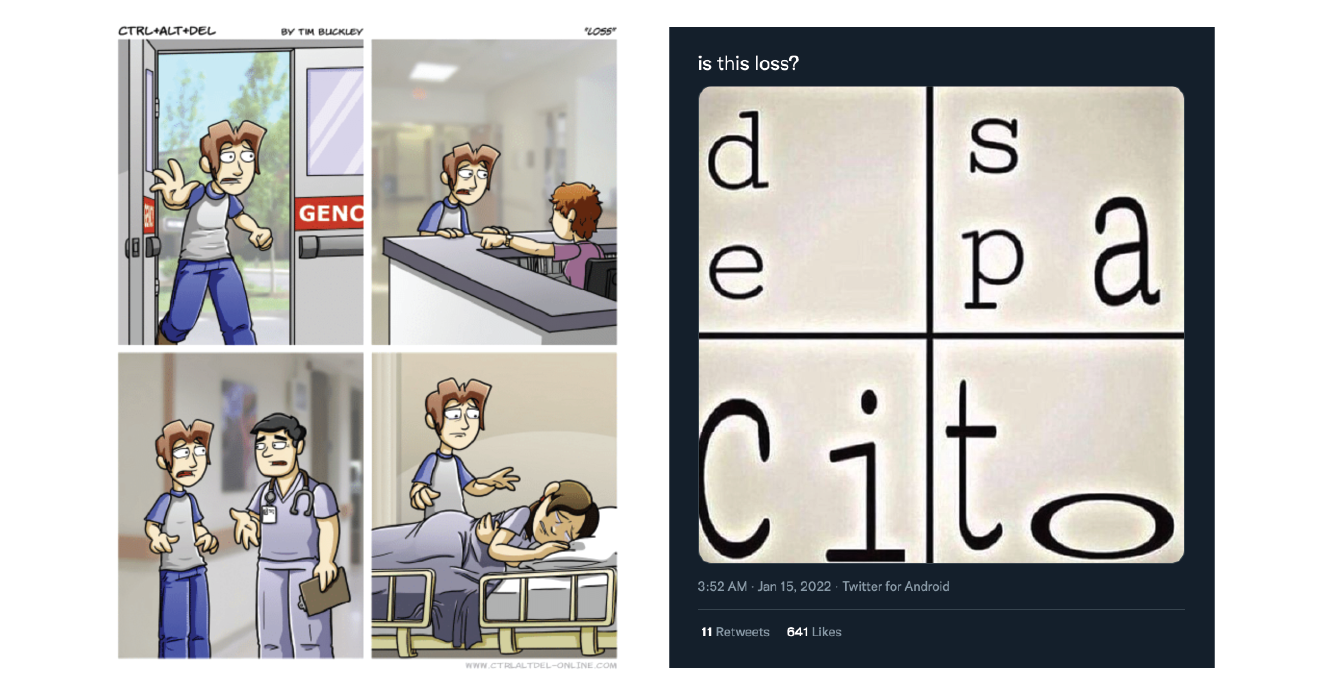
Unraveling these densely-layered references is the act of reading lore. The translation of the 2008 ‘Loss’ comic into the ‘is this loss’ meme is a good example — canonical, even — of a lore artifact folded into a set of abstract visual signifiers. The comic marks the beginning of a story’s ongoing propagation via incrementally-mutating visual signifiers. The “de-spa-ci-to” meme above tells a version of that story; it is literally ‘abstracted’ after circulating through many, many digital hands. The story itself (the lore) is the virtual substrate weaving these discrete moments together as they scatter across platforms. This unifying thread of context is preserved in the hearts and minds of those who witnessed (or read) the story’s unfolding. So, the visual cues linking the two images register only for someone already-familiar.
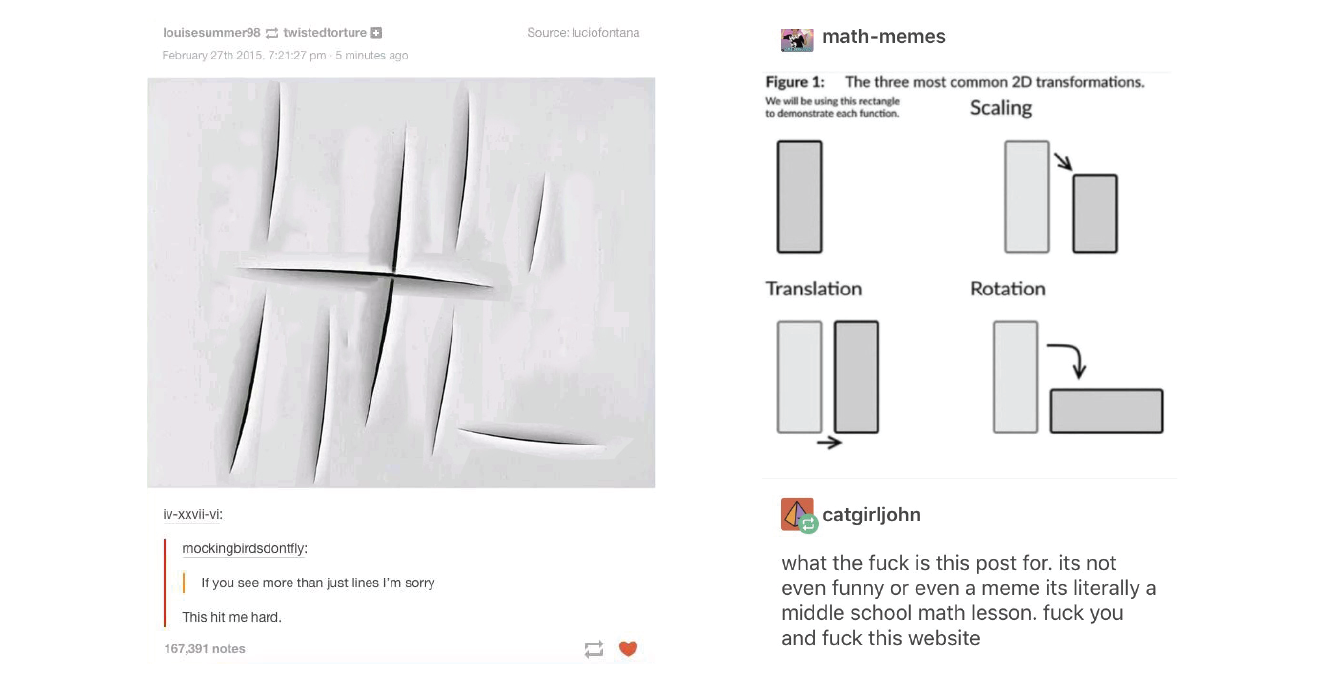
To the brave and uninformed, a chance encounter with a cryptic post is the first breadcrumb of many in a thrilling journey through its lore. The post’s illegibility is intriguing because you can tell its visual or linguistic cues point toward a virtual realm where it has meaning. Humor is often the source of its intrigue; the post is the punchline to a joke which is itself withheld. It nudges you to investigate, to reveal the directions its signifiers might point you toward. You want to understand, at least enough to be able to judge whether or not the joke is actually funny.
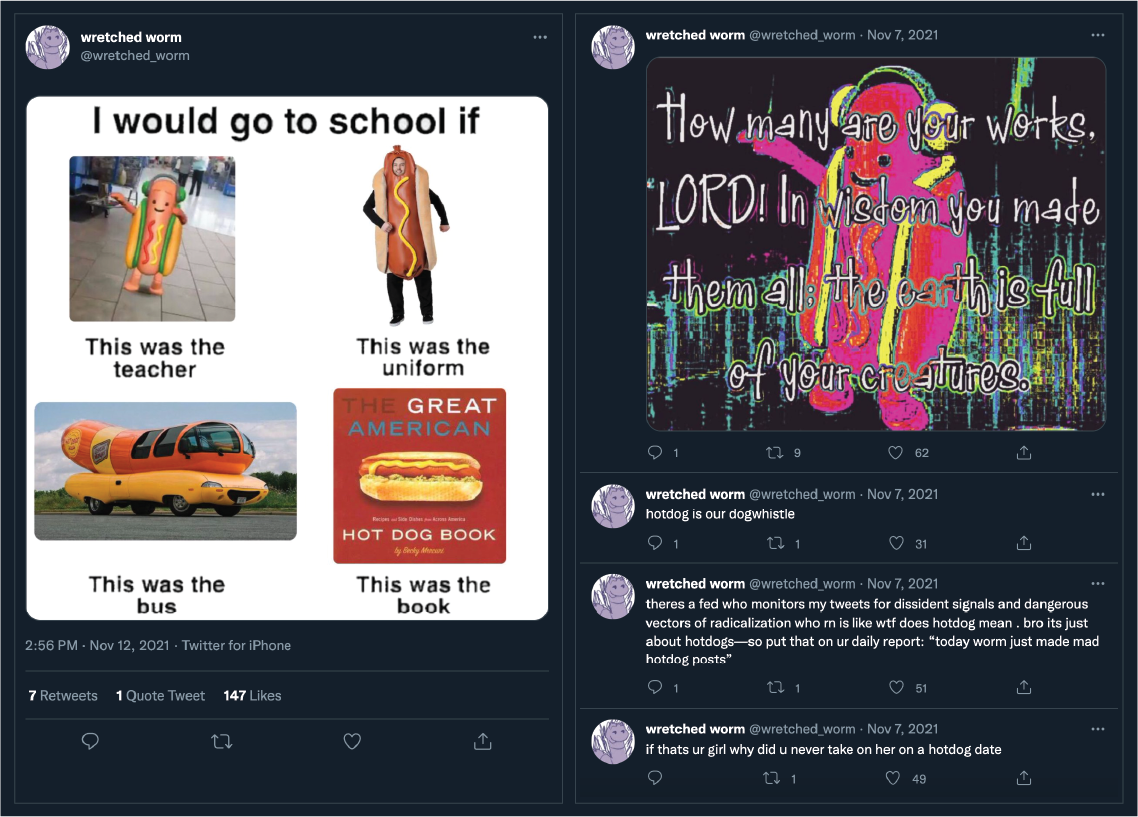
Here’s another example of memetic propagation turning a found object (the word “hotdog”, in this case) into a unit of cultural information that’s denser than it looks. Let’s say you’re unfamiliar with @wretched_worm, but one day you come across the tweet on the left. You’re confused but somehow compelled by its usage of the word “hotdog”. You click through to their profile, and see more tweets from the past few days mentioning “hotdogs”. In each instance, the word feels nonliteral, like an inside joke shared between the account and the people liking or retweeting the posts.
Gazing upon this unfamiliar use of language can even feel a little illicit, as if you’re asynchronously eavesdropping on a private conversation. You might detect a kind of sacredness to this word — "HOTDOG" — like it contributes structurally to some sort of identity unifying the people in on the joke. It feels invasive to try to unwind the idiom to reveal its meaning, since it was evidently folded away on purpose. You spot one tweet musing about a “fed” writing a report about the “hotdog posts”, and think: “Am I the fed?” But at the same time, the meme-word operates like an advertisement, beckoning you to follow the account. It winks at your curiosity. Maybe the people who know about “hotdog” are part of a cool online clique that you, also, could one day be part of. Or perhaps “hotdog” doesn’t even have any deeper meaning, it’s simply a word that gains significance as it’s repeated. But even that simple fact of recurrence-over-time seems to automate a story. It elevates the fragments it links together above the surrounding sea of discrete, atemporal content populating your social media feed, like beacons illuminating pathways through a tangled, dark forest.
[Mis]reading the Internet
Once an idiomatic post has caught your attention, how do you decrypt its symbolism? You won’t find an extensive, vetted Know Your Meme entry explaining the story behind a @wretched_worm tweet like you would for the well-known ‘Loss’ meme. It’s plausible that such a formal description hasn’t been written down, since the small group of people who employ an idiom like “hotdog” are the same ones who constructed its meaning in the first place. Or maybe you just don’t know how to find the site where those explanations are compiled, because you can’t come up with the right keywords to plug in.
This kind of jokeless punchline cultivates an esoteric, alluring aura. It attracts people like journalists or ‘cultural analysts’ who want in on the joke in order to document and publish the story it tells. But this type of narrativization often seems incompatible with the jokes — it’s like the aura evaporates as soon as it’s contained to a static form. Attempts to translate it into a meme-wiki article, blog post, or — God forbid — a New York Times thinkpiece tend to underwhelm the people already in on it. Take the recent Vogue headline announcing that “The 2014 Tumblr Girl is Back”: the article produced a grumble of disapproval among these alleged “Tumblr Girls” across social media. They scoffed at the journalist’s reading of their posting sensibilities as a simple revival of older aesthetic categories. One tweet describes the “tumblrina lifestyle” as “a closed practice”— if you want access to the real story behind its visual signifiers, you’ll have to audition first.

To insiders, it’s not just that the journalist’s demystification ruins the fun of exclusivity; rather, the journalist’s story actually feels incorrect. It’s based on a fundamental misreading of the lore. This interpretation imposes a textual linearity on a story that is by nature dynamic and conversational. It assumes a level of objectivity in the evidence it gathers that simply won’t be found in the artifacts of internet lore. These traces don’t behave like physical evidence, which you can hold and examine under a microscope. Posts take on a parallax effect when viewed outside of the immediate context that produced them. Even when looking at all the same artifacts framed in a screen, some perspectival trickery causes them to appear differently to newcomers. Any perspective, once fossilized in static text, might look like a misreading. But it’s especially wrong if it dresses itself as the official reading.
An example of such a ‘misreading’ we’ll discuss centers around something called — to those who’ve been on Twitter lately, I’m so sorry — “the vibe shift”. But we’re not concerned with the content of the lore here (i.e. what the term means, or which event it describes). What’s interesting is its form: “vibe shift” as a linguistic artifact of a community’s internal world, and its subsequent misreading in the hands of the digital public. The story begins last summer, in June 2021, when some people collectively experienced a digital moment and dubbed it “the vibe shift”. Soon after its coinage, the term, catchy and unspecific on its own, propagated itself around social media. It quickly exited the scope of in-group knowledge that birthed it, presenting itself to outsiders as a canvas onto which to project their own meaning. Sean Monahan, former K-HOLE trend-forecaster, picked up the term and published a blog post in which he describes “the current vibe shift.” In this post, he uses the term to name an aesthetic movement (trend) he’s observing across wider culture. To illustrate this “shift,” he includes an image of a meme that, at the time, had been circulating Twitter and Instagram. In the screenshot he embeds, the meme has been reposted and captioned “One Path for the Internet” by art writer Dean Kissick.
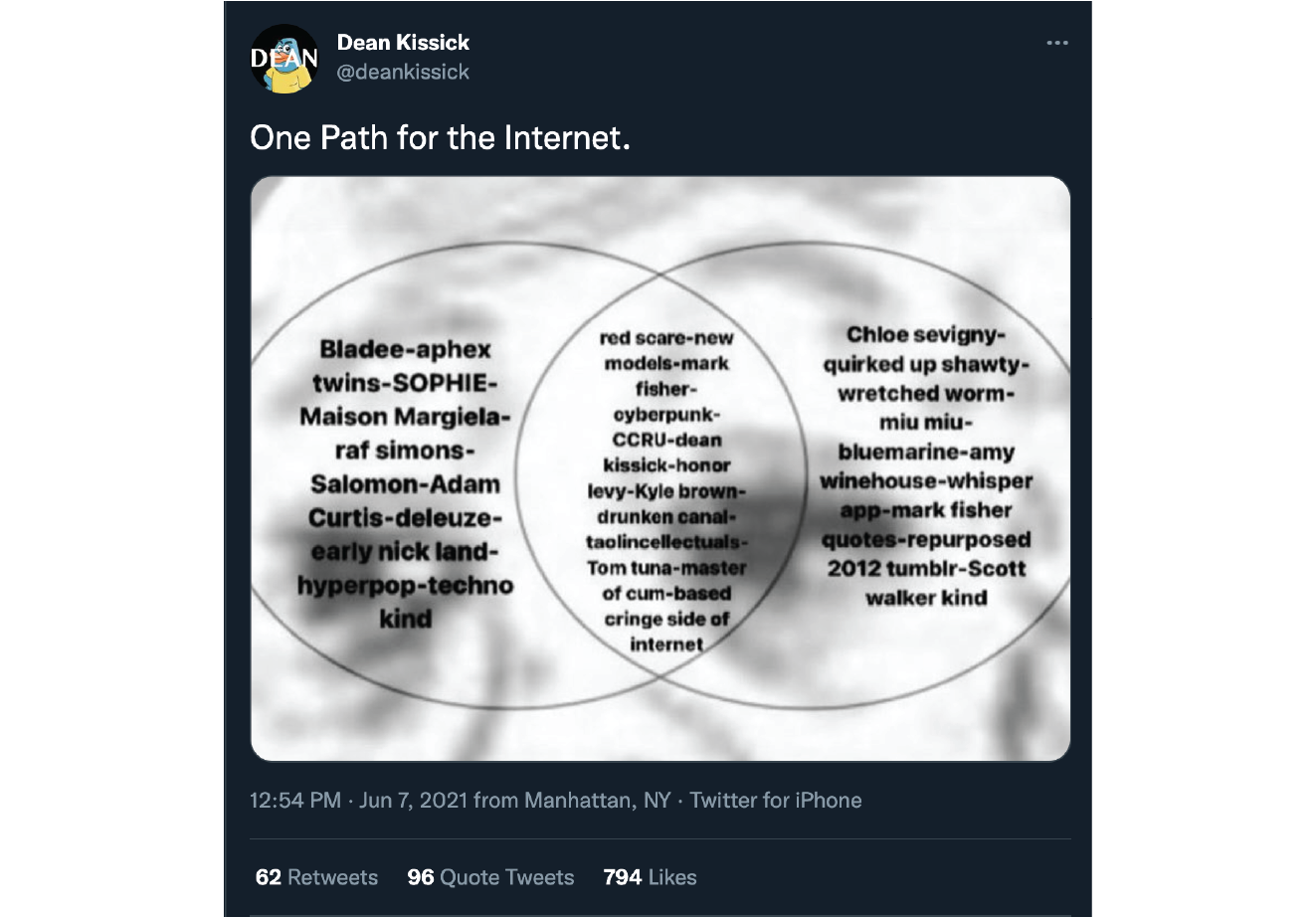
This meme presents a cluster of references bucketed into a venn diagram, suggesting that each maps to the distinct subcultural identity of a certain “side of the internet.” It invites you to connect the dots between the terms and see a kind of picture. If that image does emerge, and looks like an archetype of yourself or people you know online, you might feel anxious — as many did, according to Monahan, upon seeing the meme. This tracks, if you check the quote tweets on Dean’s post. Commentary includes “man if I figure out what this means and learn it's making fun of me I'm gonna be more than a lil bit cross”. In his Substack post, Monahan writes, “The general anxiety the meme has engendered is evidence of a vibe shift.” But the essay sparked disdain among the in-group that popularized the term “vibe shift” (along with some of the other references that made it into the above meme, itself another object of their contempt). They saw Monahan’s deployment of the idiom as an improper usage.
One such in-group figure, fellow Substack user Paul (from bible), penned a response essay describing why Monahan’s writing reflected a misreading of the online vernacular. Of journalist-outsiders recklessly concretizing the ambiguity of found memes and language, Paul writes: "They don’t know how to read the internet." And if you don't know how to read the internet, you’re lost. Any arrangement of idioms that you're trying to analyze will remain "a schizophrenic mess of signifiers you’re unable to completely grasp the meaning of, in a virtual city where you’re constantly missing the train and unable to show up to anything on time."
In my view, failure to read the internet isn’t about being “unable to grasp the meaning”. Rather, it’s about imposing singularity (”the meaning”) on a story that structurally defies definition. There is no “one path for the internet”. The trouble is, the “one path” metaphor does make sense, intuitively. As we encounter signifiers wafting through the digital wild, our gestalt-pilled brains instinctively try to anchor them to context. As people trained to literally read, we see terms like “quirked up shawty” and desperately open up Urban Dictionary. Once we have enough pieces to work with, we linearize. We thread the signifiers into a coherent narrative, which helps us see how its content ties in to our wider understanding of culture. Like a jigsaw puzzle that depicts a map on completion, the narrative orients us in a semantic landscape, pointing toward legible conclusions. It’s a bespoke ‘one path’ for each who solves the story. It’s a nugget of clarity that’s as rewarding as it is limiting — it edits out all the other pathways in order to accentuate the one that makes the most sense to us.
The map you make ends up behaving like a mirror. It can only present an approximation of the living connections between contextless signifiers, cropped to your personal frame of reference. The result is an abstraction that reflects your own pre-existing knowledge (along with whatever you found on Google). The venn-diagram / floating-signifiers meme format performs well in circulation because it accommodates such abstraction. Anyone who looks at it and sees a picture can feel as if they ‘get it’, no matter what “it” looks like. But it seems impractical to formalize your own linearized mapping of the signifiers, writing it into an article or Substack post as if it’s the map, or the “One Path” toward a large-scale cultural movement. In doing so, you underestimate the multitude of pathways there really are through a set of nouns and descriptors floating around online. These virtual paths might lead anywhere — the emptier the signifier, the further it can float.
How to Read the Internet
So, how do you read the internet? Or, more specifically: how do you read internet lore? Paul (from bible) invokes a kind of reading by proximity: “if you stay in your neighborhood, you’re never going to know what’s happening in other parts.” You learn by inhabiting the sites where people are deploying idioms and making (or unmaking) their meaning. Real-time participation, more than passive studying, produces literacy in a language that is always evolving. That language isn’t mapped to our standardized dictionaries, but to the ones embedded in the lore’s internal world.
If Googling the idioms and retrofitting them to existing textual models doesn’t explain their niche usage, you simply must follow the lore — you nudge your e-body into its current and float along its path. As it takes you from site to site, a story unfolds in real time. You read its words as if you’re hearing them momentarily reverberate through the air, because they’ll never reappear in quite the same way again. If you’re not there to hear a certain version, you’re too late. This feeling, like you had to be there, seems nonsensical in a medium that is ostensibly a perfect, static record of written information. But when that data isn’t easily searchable, accounts, scenes, and aesthetics are what you follow.
You can scroll through old posts to simulate a story’s unfolding. But to read this way is to treat these artifacts like the text in a book, as if the words and images themselves comprise the lore when rearranged properly. And, in a formal way, the legacy of an internet event is like a book: the visual inputs and outputs it occurred through can persist and be replayed, over and over. But it, like all books, is a fake book. It doesn't objectively describe the event; rather, it transcribes its traces. Since these traces remain dynamic, they synthesize into a whole that is constantly morphing. So, for each internet event, there might be infinite different books documenting versions of its occurrence. The version you get to read depends on how and when you encountered its artifacts.
Since these lore artifacts remain alive and responsive to our touch, it’s like we’re actually writing the internet as we’re reading it. A digitally-preserved event unfolds differently each time we interact with its traces, reacting to our queries and decisions, imposing on us a kind of authorship. In the words of Foley, such events recur, but don't repeat, "varying within limit" upon each instance. This is why reading lore can be a lonely experience. You see through your own viewport, with its own set of interactive variables. But it’s not always lonely. The difference between your experience and another person's can be minimized until almost negligible. This simulates an actual collective experience upon which a consensus can emerge. It can feel like you're close to each other, thus close to that potential consensus about what’s happening.
For an experience to feel communal, it helps to have a shared vantage-point. When an event’s context is centralized to a fixed digital space, it’s easier for participants to view from similar perspectives. A good example of such a contained, synchronous internet event is the @ad_god TikTok stream from our previous post, which occurred via one broadcasting source. As long as you were plugged-in while there were developments in the gameplay, you'd likely have a similar memory to someone else who was present in those moments, thanks to the controlled interactivity of the stream.
But in the case of the tumblrinas or the vibe-shifters, consensus is slippery and — I daresay — decentralized. It remains confined to the in-group while its runaway artifacts lend themselves to infinite readings, far removed from original provenance. This makes it easy to co-opt — eventually, a journalist-figure comes along to manufacture and publish a pieced-together origin-story. We could say that this is what Monahan’s Substack trend forecast did to the “vibe shift” that Paul’s online community experienced. And a full 8 months after that, The Cut surprised us with an article replicating the phenomenon at the level of mass media. The article, like Monahan’s essay, uses the term to describe a trend. It writes “the vibe shift” into formal history — the paper of record — leaving the lore in the dust. The term has joined a Google-able lexicon, its meaning tied to a broadly-legible story bearing no relation to the one it emerged from. Having triggered the “anxiety” Monahan wrote about back in June on a new, viral scale, “Vibe Shift” even has its own Know Your Meme entry now. As of late February, the wiki credits Monahan as originator. Those who render the unreadable readable are rewarded.
I guess it’s fitting that the articles exclude the raw material behind the “vibe shift” lore. The in-group posts that Paul cites rely on context that simply doesn’t translate. Lore isn’t written in stone like the calcified records of official history you’ll find in static media. It’s traced in sand, its form ephemeral and its meaning malleable. Reading the internet is moving through information that’s situational, emerging in fleeting snippets.
Navigating the Semantic Apocalypse
If reading the internet is a kind of moving, the logic determining how we navigate seems analogous, in some ways, to how we move through the physical, verbal world. But it’s also very different. Proximity to virtual lore depends not just on distance and time, but trajectory. By ‘trajectory’, I mean the particular sequence of artifacts that incrementally pointed you toward an online space (which could be anything from a single post, to a group-chat, to an entire platform). Your trajectory informs how you interpret that space and what it leads you to explore next. It’s like how one's personal provenance affects how they navigate places in the world, only on the internet, it’s even more personal. Movement is contingent on an unpredictable blend of user input and platform agenda, lending to widely variable, thus more bespoke, trajectories. It’s less like following roadsigns through traffic than floating along an algorithmic current. You steer, through millions of gestures — mouse-clicks, making small decisions — reacting to forces, without much idea of a larger route. Sure, we can generalize about ‘One Paths’, like a good “[X] to [Y] pipeline” meme). But we can’t really see them like we can IRL, where signs are literal objects. There are no spatially-evident patterns of erosion indicating paths well-trodden, like trailheads at the base of a mountain.
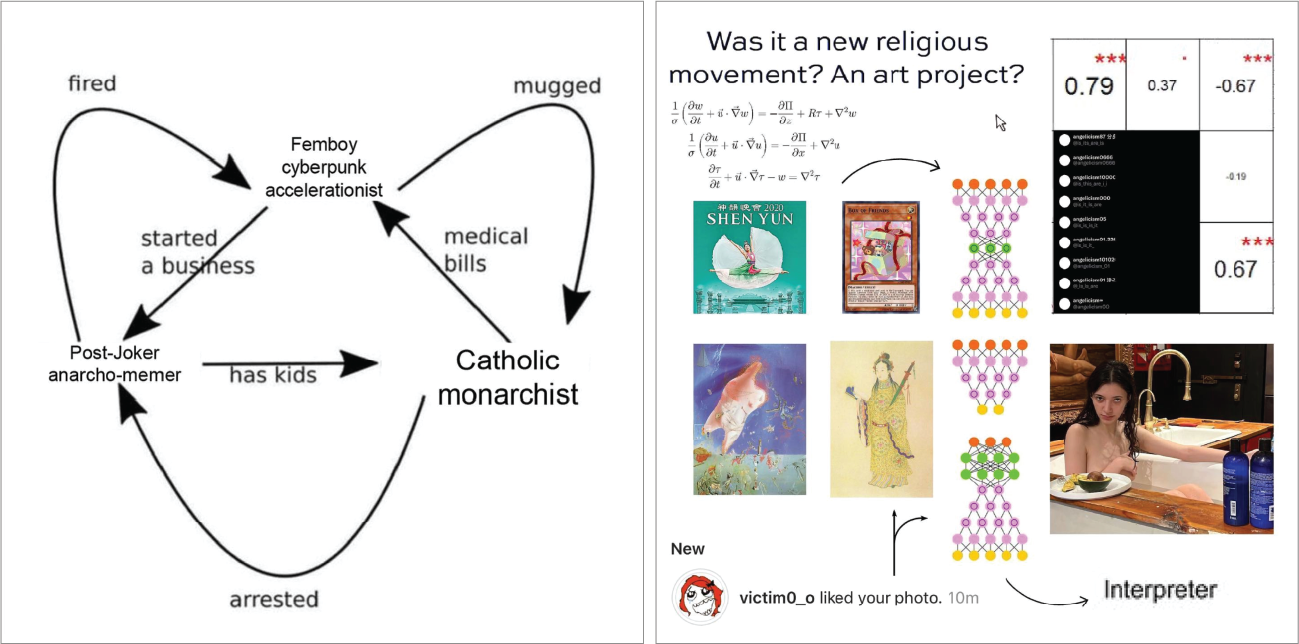
Digital ‘erosion’ takes a shifty, subjective form. It might appear as a UI element telling you what to look at, how many ‘likes’, a list of mutual followers. It’s personalized, part of a wayfinding system visible only to you, in fleeting flashes of light. It often comes from a recommendation algorithm, which in the words of Aaron Z. Lewis, acts like “a funhouse mirror that reflects back a warped image of whatever you hold up to it”. This is an important distinction: virtual lore artifacts do act as signposts, pointing toward paths of inquiry, but instead of being fixed in a space and time shared with other wanderers, those properties are malleable and impressionistic. You may end up in a place that many others occupy, like a group chat, but your orientations will only relate to the extent that you, as a group within this place, describe and then calibrate upon shared reference-points.
In many cases, this “calibration” happens through a formalization of the lore that weaves a community’s reference-points together. It’s often purely for internal benefit, to keep track of canonical content. For example, there’s a practice on 4chan called ‘baking a thread’, which imposes order and slowness against the platform’s chaotic flow. Or sometimes, a meme’s originator will cast themself as journalist, like Twitter account roon publishing an explainer clarifying the authentic meaning of “wordcel vs. shape rotator”. Paul (from bible)’s essay countering Monahan re: “vibe shift” does something similar, but in the opposite way. He describes what “the vibe shift” is not. It’s not something that can be formally defined: “…if you know you know ... i cannot explain it, like, i don’t have the vocabulary, either you get the vibe or you don't get the vibe”. By carving out this negative space, the lore starts to take shape — the shape of something that can only be approximated. The shape of pure vibe, of which any concrete visualization will always be just one of many possible iterations.
A digital community that explicitly avoids specifying or indexing canonical readings of its lore finds informal means of consistency. Rather than writing or compiling an official narrative, they synthesize and encrypt it into simple motifs like textural words, associative images, and grammatical patterns. This shorthand accommodates the tangled, nebulous nature of the lore comprising it in a way that suits memetic recurrence beyond the in-group. What results isn’t a linear story, but a semiosphere (as we defined in our previous post). The lore crystallizes into a catalogue of visual cues that structure and signal the culture of the group. Like a brand identity composed of pure vibes.
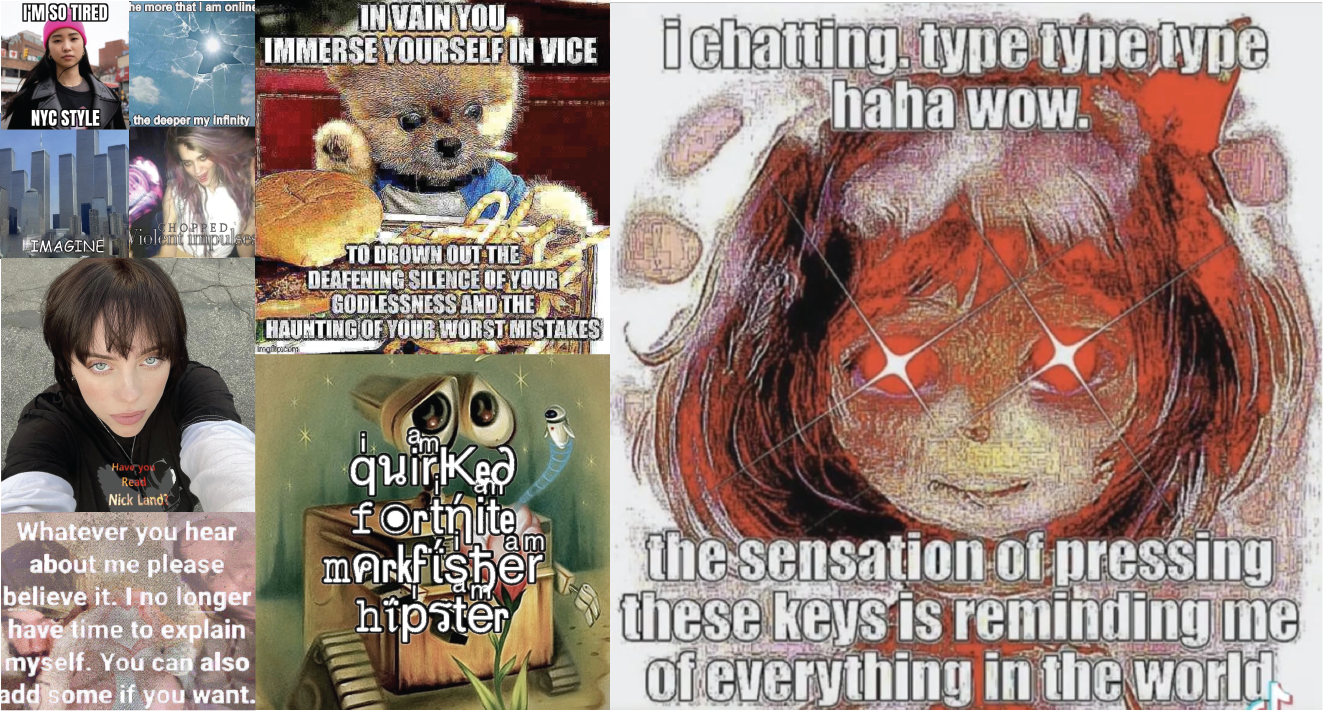
But [ironically], this sort of pure-vibe lore canonization functions with the same dynamic the “One Path” floating-signifiers meme crudely demonstrates: its legibility is contingent on one’s ability to look at an assemblage of references and see an abstracted map, oriented toward a particular cultural identity. This allows newcomers to calibrate on ambiguity itself (the vibes). In order to ‘get it’, all you have to do is accept that there is nothing to get — no context to be provided for the memes or idioms, no explanations to read. There is only the blurry picture, greater than the sum of its parts, that emerges when you squint at the collection of artifacts. The lore is easy to read, because there’s nothing to read, only to feel.
But what does it feel like to engage with lore whose world consists of pure subjective feeling? In my experience, it’s like trying to navigate a murky, viscous, zero-gravity dreamscape. You grope your way through random objects and muffled noises until you bump into someone who, perhaps, helps ground your experience in common language. On a micro-scale, this evokes R. Scott Bakker’s idea of “semantic apocalypse”: the collapse of “universal meaning-based imperatives”. Shared concrete understanding becomes merely “a matter of coincidence”, resulting in a personalized semantic rewiring. And the outcome, he posits? MADNESS.
Why does it *have* to be madness? Because we define madness according what our brains normally do. Once we begin personalizing our brains, ‘normally do’ will become less and less meaningful. ‘Insanity’ will simply be what one tribe calls another, and from *our* antiquated perspective, it will all look like insanity.
The people immediately involved in constructing meaning don’t need to formalize it, because it’s already part of them. In this way, purely-virtual lore production prefigures a kind of world-building that can be as alienating as it is generative. It encloses its participants in an alternate semiotic system that, by default, lacks glossaries or indexes. Ongoing interpersonal calibration inside one of these worlds based on vibes alone happens though “personalizing our brains”. Text and image solidifies via rampant cloning of pure language as “all syntax but no semantics” (to borrow from Erik Hoel’s application of semantic apocalypse). This begets a kind of insanity, a subversion of meaning that shrinks the scope of what and who remains legible.
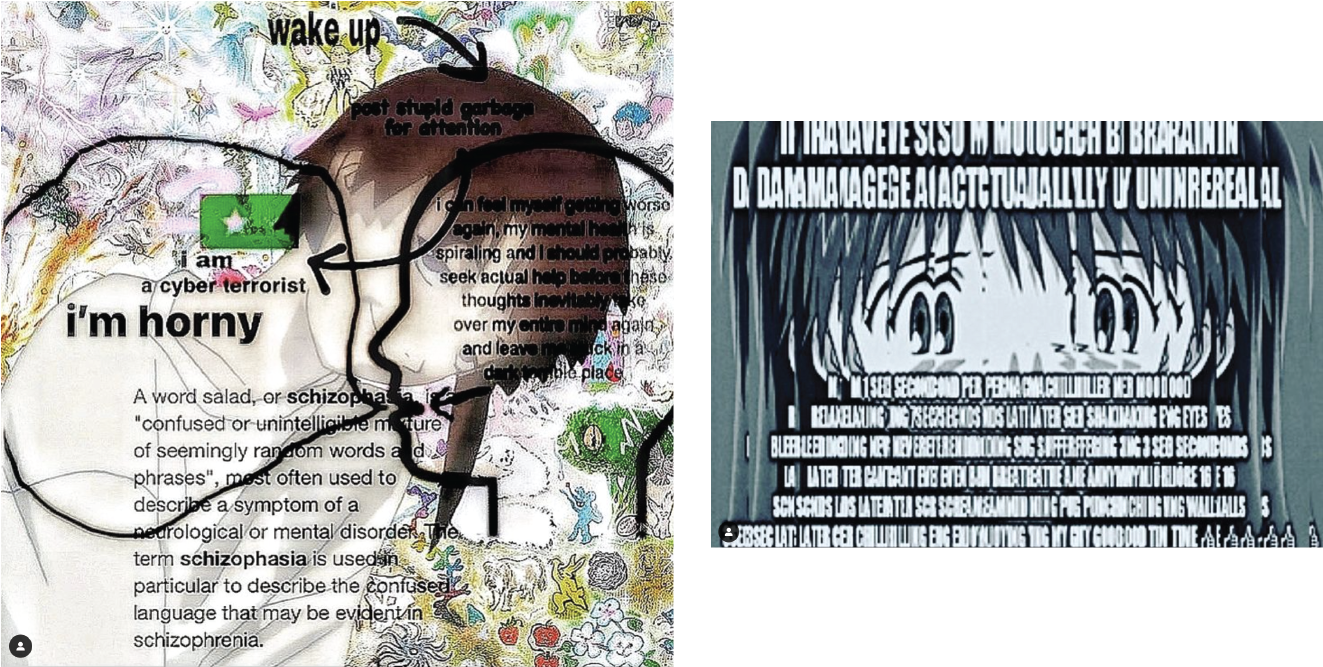
This insanity can be a lot of fun to engage with. It generates its own internal logic from the space of pure-syntax non-knowing in spontaneous displays of crowdsourced creative fervor. Friendship evolves between those who dedicate themselves to being there in real-time as new language emerges that only they are fluent in. Being able to read this insane language feels relieving — especially if you agree with Bakker that “the Semantic Apocalypse has already happened” across a society experiencing broad breakdown of “meaning solidarity”. Legibility is a scarce commodity on the internet. There’s power in signaling insider knowledge to outsiders, so naturally we see the memetic propagation of idiomatic lore artifacts beyond the bounds of where they actually convey meaning. But as time goes on, their density and alienation from more universal lexicons makes it hard for even the ‘in-group’ to keep track of this internal meaning. It’s easier to give up on maintaining consensus, and simply embrace the ambiguity. Sometimes we even celebrate the collapse of shared understanding, accelerating into our own incomprehensibility.
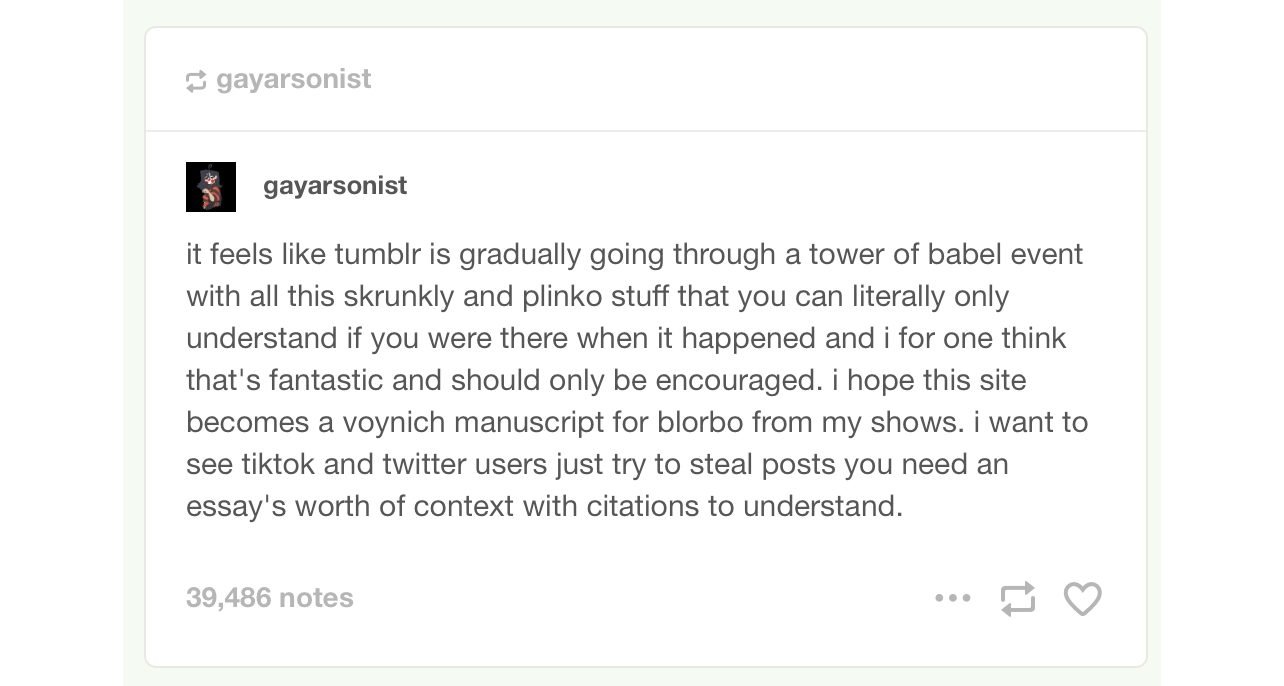
As the realm of virtual information complexifies, it is increasingly difficult to collectively experience, let alone agree on concrete descriptions of events. The platforms we use to communicate often lack archival affordances, optimizing instead for the nonstop production of new content. So context collapses and signifiers empty their meaning. When we encounter them, we fill in the blanks with our own subjectivity. Pathways fork into fractal infinity before us, and we navigate each turn with signs whose appearance is contingent upon our readings that pointed us there.
At the same time, though, we’re all learning how to read the internet. We’re adapting to what still feels like a new paradigm for communication. Following the lore through its elaborate virtual networks strengthens a different sort of sensory muscle. We’re learning to see patterns in incoherent streams of data. We can communicate the stories that emerge without language, read without comprehending, and write without prescribing. ‘Reading the internet’ is an ongoing and participatory act, unfolding stories without ossifying them. When we get it right, it can sound like beautiful Bladee lyrics (arguably the best vibe-communicator of our time):
When you look at me and hate on me, I'm a mirror (mirror)
If you look at me and don't like me what does that say about you?
I am King Nothing, I am nothing
Take a bunch of empty words and make them mean something
– Bladee, Hotel Breakfast, 2021
Learning how to read the internet can help us imagine how we might make it better. Members of online communities, if they choose to, can develop living textual canons that keep up with shifting consensus, orienting newcomers as their lore continues to evolve and trickle outward. They can build archives that accommodate the interpretive ambiguity of it communication artifacts. But in the meantime, we (’newcomers’) can practice a new way of reading the internet’s raw data streams. As story-fragments float along our path, we can assemble them into wholes with awareness that the lore we’ve reconstructed is just one variation of millions in the latent space of infinite pathways. Then, we can be ready to encounter another iteration of the story with generosity.